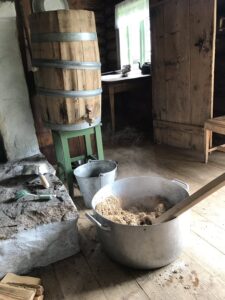Off. It’s not like I’m off doing very much but, you know, I have actual chores to do, a couple of nights in Montreal… and other day trips to take… and summer’s slipping away so maybe there won’t be so much in this week’s beery news notes. And I am going to have limited access to scribbling time during the middle of this week so let’s see what I can come up with… no one wants someone to get that sad and lonely feeling if there isn’t something to read as they slurp down their Froot Loops early this Thursday morning. Hmm. How to cover up my half arsed effort? Perhaps another slightly different format will suffice. Let’s have a Q+A session!
 Question #1: Does anyone do social media as well as Lars does? It was on display in this week’s photo essay on a little historical brewing recreation he did last weekend at a museum:
Question #1: Does anyone do social media as well as Lars does? It was on display in this week’s photo essay on a little historical brewing recreation he did last weekend at a museum:
Had to clean the inside of the rost (lauter tun, the wooden vessel), because it was mouldy. Hard to avoid with wooden gear… Foundation of the filter is alder sticks. For color, flavor, and to give the wort space to run underneath the real filter, which comes on top…
My observations: I hates me a mouldy rost.
Question #2: do we care if we use the original language’s grammar and spelling when referring to beer related things? I am disinclined to worry about this all that much but that is not a universal thing. There’s a thread:
Not to nitpick the thriving transatlantic linguistic exchange through l/Lager, but for anyone not writing bilingual #WhatsBrewing blurbs, what generally would be pro-copy guidelines for US-ENG capitalisation in writing keller, kellerbier, but: Kellerwald?[…] My remark goes beyond the basics of why other natural languages should/can drop German capitalisation when importing, trying to get at the desired branding (“auratic”) effects of opting back in when it creates perceived authenticity, say for Scandinavian or Czech diacritics.
My thought: be consistent but be prepared for people to think you are weird when you talk about Poland’s capital amongst English-speakers.
Question #3: why should I care about NA beer? NA beer to me is expensive fancy soda pop that is made in an unnecessarilily convoluted manner. I thought of that on Monday when Stan reported from the World Brewing Congress:
Today there will be three presentations related to making sure non-alcoholic beers are safe to drink. This is important and was already on my radar when I read “How Mash Gang is Breaking the Alcohol Free Mould.” That is not to imply that Mash Gang beers are not safe, or that the story should address what the company is doing to assure the beers are free of pathogens. It simply reflects my current fascination with what brewers might do to make non-alcoholic beer better without the many useful functions ethanol performs. One of those is making beer safer to drink.
My concerns: in addition to a swath of cheaper established competition, the idea that NA beer has not solved the sanitation issue is decidedly off-putting. And this may well explain in part last week’s omission. Plus it was a very bobby B.O.B.
Question #4: do you miss RSBS as much as I still do, all these years later? Answer: well, we may have a form of this care of Boak and Bailey tinkering around at BlueSky. They have set up a list that allows you to follow all added on that list to effectively create a aggregator displaying those who sign up for those who follow. Have a look.
Question #5: do any of you not draw lines in the sand? I am 100% on board with Laura Hadland this week in The Drinks Business:
I have a personal blacklist of the companies I will not deal with because of their past actions. I don’t write about them, I don’t spend my money on them, I don’t visit them. This quiet boycott is a private affair. If I don’t agree with someone’s ethics, I don’t fan their flames. There are so many fantastic businesses out there that I do want to shout about, it’s rarely an issue. Last week, however, I was approached by a PR company offering me a spot on a very interesting project. I was feeling pretty excited as I scanned through the details. Until I spotted one of the toxic names from my blacklist. Deflated, I immediately replied to the email letting them know that I could not participate. I told them why too. That was that. It felt quite good for a minute.
My total concurrence: I won’t ruin the punchline but, again, go have a look.
Question #6: so if the CBHOF is using the Baseball Hall of Fame nomination process, will the “good character” rule also apply? That states:
Voting shall be based upon the player’s record, playing ability, integrity, sportsmanship, character, and contributions to the team(s) on which the player played.
So, given the recent years’ allegations of sexism, racism and a bunch of other serious -isms in craft beer… how will that be taken into account? See, working as I do in governance, I can assure you that there is always a set of process rules that run along side the substance rules in these things. You can have the greatest process in the world but they only affirm the substantive standards which have to be set out before any nominations are considered. Do we know what they are?
Question #7: does my national, regional and local construct for North American craft hold water? Jeff asked for more:
I think we should talk about local and regional, since you hinted at it and Stan picked it up but didn’t elaborate. I am hesitant to respond without understanding your fuller take.
My point: all those nice cans from the like of Sierra Nevada and Sam Adams fill grocery store and gas station shelf space where other distributed beers used to be found. As I said, “basically I see that one of the tensions is framed by the economics of investment required for scale. Locals have done well. Turns out there was space for a few big grocery store national craft breweries but at the expense of those intercity / interstateers.” See, I think that the mob of ankle nipping locals can defend themselves from big craft in each market but regionals have found themselves, for a few years now, neither here nor there.
Question #8: Maybe related, is there any passing of a micro era brewery more shocking than the closing of Cambridge Brewing C0mpany which will serve its last beer on December 20th? The notice was on Instagram:
We were the first commercial brewery to produce a Belgian Style beer in this country and one of the first to embrace multiple yeast strains in-house and even to intentionally invite wild organisms into our brewery…. A heartfelt thank you to all who have participated in our dream. To our customers that have joined us time and again over the years, your support and friendship enabled our success. To all that are working or have worked here, you guys are what made this place so great. What an honor and a joy it has been to work alongside you! So please join us often over the next 4 months! We still have Patio Season, Festbier, Fall Menu and more coming. 35 years, one hell of a run.
 My thoughts: Perhaps it’s an east coast thing but I heard about CBC long before I had ever visited. Along with Shipyard and Gearys in Maine, it was a name I heard when I was a young beer fan in Nova Scotia, a name spoken with reverence by those coming back from the Boston states. Then in 2013, we found ourselves right there and witnessed the making of pumpkin ale with the actual pumpkin harvest and made a bit of a photo montage over at FB. Get over to CBC while you still can.
My thoughts: Perhaps it’s an east coast thing but I heard about CBC long before I had ever visited. Along with Shipyard and Gearys in Maine, it was a name I heard when I was a young beer fan in Nova Scotia, a name spoken with reverence by those coming back from the Boston states. Then in 2013, we found ourselves right there and witnessed the making of pumpkin ale with the actual pumpkin harvest and made a bit of a photo montage over at FB. Get over to CBC while you still can.
Question #9: What the heck is “hop preparedness” anyway?
Question #10: Has Ron out-Ronned himself with this dialogue? It’s a two-part play between father and son as they recall visiting Dad’s old home town:
“Marks and Woollies next door to each other and Boots over the road. Used to be typical of a UK high street.”
“But now they’re all gone. I’ve heard this story before.”
“They aren’t, though. Boots is still there and Marks has moved to by the old Warwicks brewery.”
“Loads of pub pictures coming up, I suppose.”
“There sure are, son. There sure are.”
“Don’t talk like John Wayne, Dad.”
My response to these things is always that Ron missed his calling as an author, getting sidetracked into a pub as he was at age twelve. Fabulous bit of writing.
 Question #11: did you have any beer in Montreal? Yes, on Tuesday a cask brown ale at a funky fermented veg place called Poincaré and also a Mexican style lager at La Capital Tacos. Both were local beers but to be honest the food outshone them. Fish terrine at the first place before crossing St. Laurent to the other for Pastor tacos. We walk, we eat. We eat, we walk.
Question #11: did you have any beer in Montreal? Yes, on Tuesday a cask brown ale at a funky fermented veg place called Poincaré and also a Mexican style lager at La Capital Tacos. Both were local beers but to be honest the food outshone them. Fish terrine at the first place before crossing St. Laurent to the other for Pastor tacos. We walk, we eat. We eat, we walk.
Last question, #12: why did it rain all Wednesday? We still saw the penguins and marched around town but I feel like moss is growing behind my ears. My nooks and crannies felt a certain alliance with the wild managed orchards of Cidrerie du Golfe in Brittany as featured in Pellicle this week which contained this excellent facts:
Their emphasis on nature is a way for them to preserve cider’s heritage, they say, strongly attached to rurality and peasantry. A tradition partially lost since the World Wars, when cider was relegated to second place in the region. “Soldiers were given red wine in the trenches while cider was distilled to be used in weaponry, it changed people’s habits,” Virginie says. “Before WWI, people in Rennes were drinking up to 400 litres per year!”
Used in weaponry! Heavens. Well, that’s it. Enough of this inquisition! I wrote half of this on an iPhone. So it is what it is and we all will simply have to live with that. Here are the credits, the stats the recommends and the footnotes and the many ways to find good reading about beer and similar stuff via any number of social media and other forms of comms connections.* Want to keep up with the news before next Thursday? Check out Boak and Bailey every Saturday and Stan back each Monday… with a top drawer effort this week. Elsewhere go look at then listen to Lew’s podcast. And get your emailed issue of Episodes of my Pub Life by this year’s model citizen David Jesudason on the odd Fridays. And Phil Mellows is at the BritishBeerBreaks. Once a month, Will Hawkes issues his London Beer City newsletter and do sign up for Katie’s now revitalised and wonderful newsletter, The Gulp, too. Ben’s Beer and Badword is back with all the sweary Mary he can think of! And check out the Atlantic Canada Beer Blog‘s weekly roundup. There is new reading at The Glass which is going back to being a blog in this weeks best medium as message news. Any more? Yes! Check to see the highly recommended Beer Ladies Podcast. That’s quite good. And the BOAS podcast for the bro-ly. And the long standing Beervana podcast …except they have now stood down. Plus We Are Beer People. The Boys Are From Märzen podcast appears suspended as does BeerEdge, too. But not Ontario’s own A Quick Beer. There is more from DaftAboutCraft‘s podcast, too. All About Beer has introduced a few podcasts… but some may be losing steam… until… Lew’s interview! And there’s also The Perfect Pour. Plus follow the venerable Full Pint podcast. And the Craft Beer Channel on Youtube. The Moon Under Water… is gone which is not surprising as the ask was $10 a month. Pete Brown’s costs a fifth of that but is writing for 47 readers over there. There was also the Beer O’clock Show but that was gone after a ten year run but returned renewed and here is the link! Errr… nope, it is gone again.
*This week’s update on my own emotional rankings? Facebook still in first (given especially as it is focused on my 300 closest friends and family) then we have BlueSky (+13=146) rising up to maybe… probably… likely pass Mastodon (929) in value… then the seemingly doomed trashy Twex (-2=4,464) hovering somewhere well above my largely ignored Instagram (160), crap Threads (52) with Substack Notes (1) really dragging up the rear.
